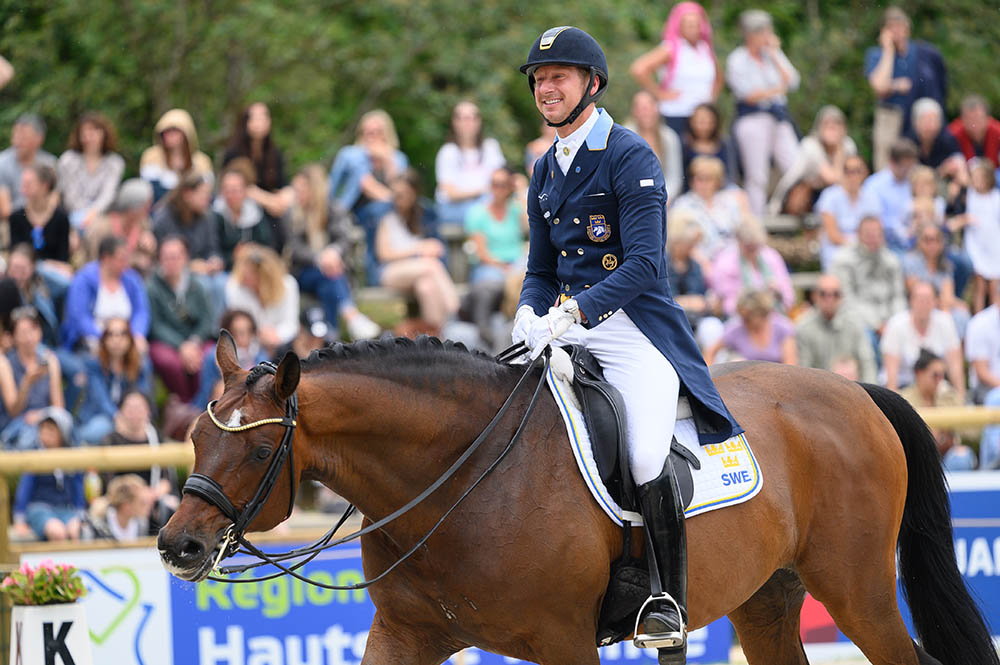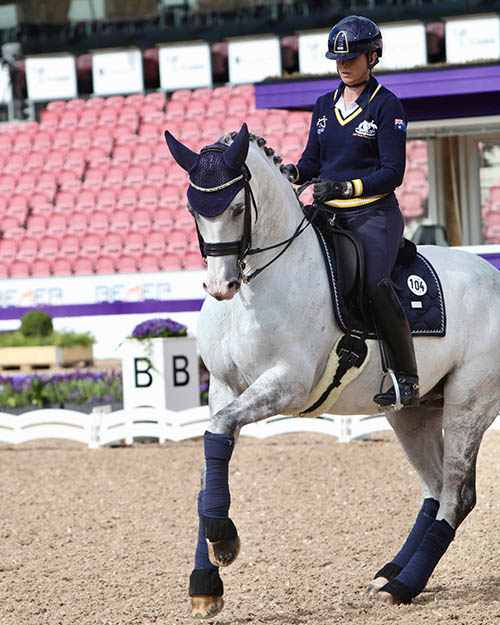I’m always curious as to what makes people tick. What makes them more competitive… more driven… better prepared… better in a stressful situation.

“They want to ensure
they leave nothing to chance
and are prepared.”
Over the years I have been fortunate to watch the best of the best prepare and compete, not only as a competitor but also as the wife to one of the top riders in the world and friend to many of my competitors. Spending time behind the scenes has taught me so much and is a topic that has become more thought-provoking of late.
Whilst each individual has their own set of strengths and weaknesses, I’ve noticed each nation at the top does things slightly differently.
THE DANES
The focus and preparation for their team for the World Championships in their home country in 2022 was second to none. Goals for their performances were set years in advance and step by step they followed their plan to ultimate gold.
Speaking to Cathrine Dufour, she explained to me that straight after the 2018 World Equestrian Games in Tryon, the testing began to identify emerging talented combinations to assist them to be ready for Herning. Essentially, they wanted more than just two to three talented combinations able to get top scores to assist in team performance and developed the talent with this focus.
Cathrine says for her this is really where the Danish stand out, as they recognise they don’t have the depth of combinations in numbers compared to other nations, such as Germany. So they test combinations at specific shows and find the best way to develop and support that combination specifically.
Horse security was also key for Denmark. Even when horses were sold with the potential to be on the team, arrangements were made to have the horse secured for the Championships.
With regards to behind the scenes, the Danish really practise as a team and do regular clinics in different environments, including competition facilities. They work hard to be prepared for anything. Surrounding their team with advice from judges, the eyes and experience of Nathalie zu Sayn-Wittgenstein, mental coaches, etc., they want to ensure they leave nothing to chance and are prepared.
After the World Championships, a new approach has been implemented with the aim of the 2024 Olympics. The Danish now wish to utilise an expert team of individuals within the international dressage elite, and not focus on one elite trainer, with their “expert trainer” named as Wolfram Wittig. This will be interesting to observe after so much success with the system they have implemented for years, and which is envied by many other nations.

“The Swedes are also very
much about team bonding.”
THE SWEDES
I’m very fortunate to watch and learn so much from this team year after year. Now, note that equestrian is the second biggest sport in Sweden only behind football. For me this is insane, but you feel it in Sweden when you go to competitions and the crowds are huge! I will never get used to Patrik having a following like a blond Harry Styles. Patrik is followed by people wanting photos, and even had screaming girls! This recognition is quite the norm for equestrian athletes in Sweden.
Whilst this passion for the sport and its sheer size has no doubt a positive impact on their success, it’s their consistency in which I believe their real strengths lie. Sweden has had for many championships the same Grand Prix and Swedish representative and Olympic medallist Louise Natthorst, the same team Chef d’Equipe and the same selection policies. They keep it simple, clear and consistent and their performances as a team mirror this.
The Swedes are also very much about team bonding. They have regular team trainings, mental therapist coaching and dinners throughout the year. Post championships they meet together and reboot, discussing what works and doesn’t and what are their new goals.
Finally, the Swedes think ahead. They have a special series of classes sponsored by Lövsta (an Equestrian Centre and breeding program sponsored by the uber-successful businesswoman Antonia Margaret Ax:son Johnson) that run through the year. These classes are there to support and nurture future horse and young rider talent and then have a final for the Under-25 and Young Horse Grand Prix, together with the “Top 10 Dressage” at Sweden International Horse Show (an elite class where the top 10 riders in the world are invited to compete for the biggest prizemoney available for dressage in the world and also sponsored by Lövsta!)


THE GERMANS
The well-oiled machine, Germany’s tradition in the sport is such a strength. With established training systems, consistent coaches at all levels down to ponies, depth of talent, and a clear selection policy overseen by experts who are elite championship riders and coaches, Germany produces the goods time and time again.
The phrase “you are only as strong as your leader” resonates for the German team, with Monica Theodorescu and Jonny Hilberath there together or singularly competition after competition. They are invested in their team and the process of developing their country’s riders.
A sense of equestrian community is very strong in Germany. From an early age, through their very established systems, children are nurtured and trained on ponies, with championships and a great level of cohesion throughout levels so riders seamlessly flow up the levels to senior with continued support.
The ability to handle pressure also begins at an early age. Combinations are identified early and are expected to perform at a high level. And as the depth of talent in rider and horse is so deep in Germany, if you aren’t doing your best, someone out there will be ready to take that spot. History shows Germany is a medal-winning country and it is almost expected that this continues and the pressure with that is high. But they learn to deal with it and are ultimate professionals at an early age and can handle all the competition world has to offer.
The ability to deal with their issues internally is also a massive strength. If a competition doesn’t go well, or there are any issues, they are dealt with internally. I don’t think there would be much sugar-coating it, but that’s what makes them strong time and time again. They say it how it is: you deal with it and you grow forward and move on in a more prepared way with the issue addressed.

“Following their own plan is
also something the British do well.”
THE BRITS
One name. Carl Hester! When you look over the teams of the past, Carl has had some major involvement in each rider and their development. Even now with Lottie Fry, it was Carl who got her the position with Van Olst Horses.
The British are very clever and skilled in the arena and make it look effortless. Behind the scenes it’s a lot of power play and transitions; it simply doesn’t come from floating around, although that’s what it looks like in the arena. Meet Charlotte or Lottie in a warm-up on a diagonal – they are going for 12s with full gas! And finding their brakes so they can show a more smooth and effortless movement in the arena.
Following their own plan is also something the British do well. They are exceptional at choosing the right shows and often don’t come across to Europe too much. This lack of comparison often works in their favour and is a smart move.

THE AMERICANS
What a well-oiled machine. Their team unity is something to behold. Everyone, including owners and support crew, are dressed in their team uniforms at all times. Their presence is felt as big and unified wherever they are.
Also, their ability to manage their team to be ready for a championship is textbook. Often you are left wondering how the Americans will get a team ready that is strong enough or seasoned for medal contention. But they do. Time and time again. They rest their older stars to minimise miles to ensure they can spearhead their team to success using experience and know-how.
Yearly trips for several months to Europe is also a consistent fixture in the American team. Bringing new, less experienced talent along for this is pivotal to their success, giving them the chance to be a part of a team and learn all that comes with it and gain invaluable experience competing regularly against the best the world has to offer in Europe.
WHAT DO ALL THESE NATIONS HAVE IN COMMON?
And how can we be more like the world’s best, so we can challenge them in those top positions? I see it as the following:
- A TEAM COACH OR TEAM ADVISOR: A key person who regularly oversees the riders training at regular intervals.
- IDENTIFICATION AND SUPPORT OF UP-AND-COMING TALENT: We have so many talented riders within Australia and abroad. Let’s formally identify them, help them secure their horses, and give them the coaches, training support and mentors they need to reach their full potential. Back in 2006, Equestrian Australia sent a team to train with then coach Ulla Salzgeber. My friend Kate Taylor-Wheat and I were identified as future talent as we were winning at Small Tour and so we were offered the chance to come too with our horses. This experience was invaluable, watching the training of our more experienced riders, having help ourselves, coming along to their competitions and being a part of the team performance analysis nights. Ulla would slow down their rides on the big screen and study them in slow motion to identify how to make a movement better. It was so good! I wish we could give our younger riders this opportunity again.
- CUT THE TALL POPPY SYNDROME: Instead develop a more nurturing, supportive and less false environment surrounding our sport. Fact: there will always be someone with more money, a better horse, more talent, a better sponsor, a better trainer, more opportunities. This is an issue I hear from so many riders, and it’s causing riders to come abroad. If our sport and its riders are to develop, we need to encourage a better environment surrounding it.

- FINANCIAL SUPPORT: It takes money. Entry fees are getting higher, horses cost a lot to maintain and good trainers and the need to have them consistently is expensive. Raising money through funding is essential and Equestrian Australia simply doesn’t have it, so we need to do something about it to ensure future combinations can have the opportunities they need to reach higher. The British have the Lotto, the Americans raise their money and develop scholarship programs, and this is what we need to do.
- INVESTMENT IN A MENTAL COACH: Focusing on individual issues and ensuring the team can function and perform at its best as a team. Simple, but let me assure you, behind the scenes some team colleagues for major teams are not the best of friends. Despite this issue, the team operates as a team with daily meetings, a team dinner here and there and they get the job done… together… despite their personal differences.
As a nation, we Aussies are hardworking, driven and thrive when someone doesn’t believe we can achieve something. The “what doesn’t kill us makes us stronger” mentality is our strength. Now we need to utilise it. When combined with some of the practices of the best teams in the world, we have the talent and drive to go far. We came eighth out of 19 teams in Herning last year, the most successful of all Australian teams at the event. Imagine what we can achieve if we implement practices from the world’s best. C’mon Aussies, let’s do this! EQ
YOU MIGHT ALSO LIKE TO READ:
Two Steps at a Time for Isabelle – Equestrian Life, January 2023

